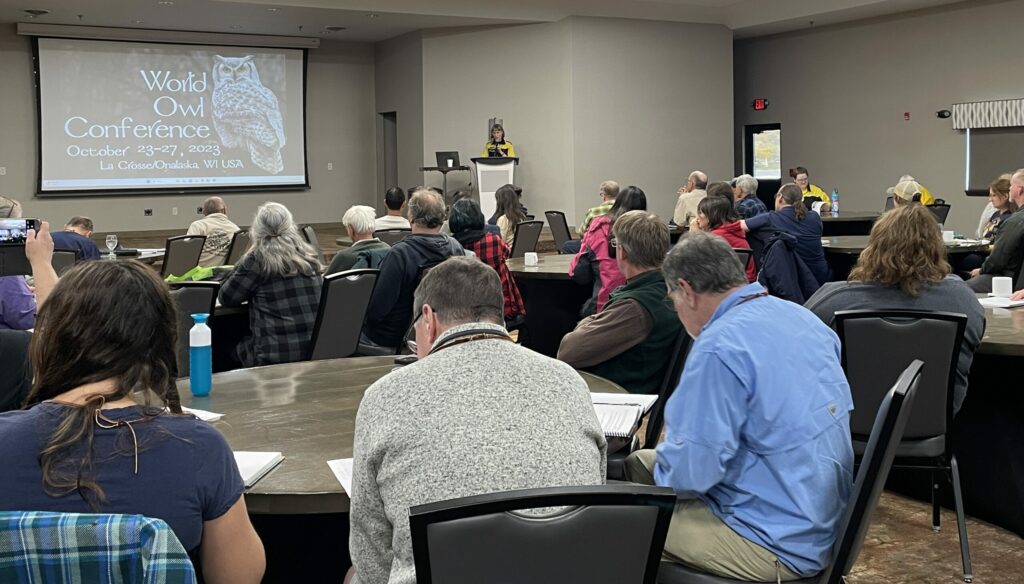
The 7th World Owl Conference in La Crosse, WI, drew 120 participants from 16 countries. (©Scott Weidensaul)
When we started Project SNOWstorm 10 years ago, it was on a wing and a prayer, pulled together in a matter of a couple of frantic weeks in late 2013 in response to the largest snowy owl irruption in the East in more than 80 years.
We didn’t plan for this to become one of the largest snowy owl research projects in the world, or to do it in a way that’s virtually unique in the world of raptor science. But it did, and it is, and others have been paying attention.
In October, I was invited to present the opening plenary address at the Raptor Research Foundation’s 59th annual meeting in Albuquerque, New Mexico, before more than 350 raptor scientists and conservationists from around the world. The conference organizers asked me to outline how we’d built SNOWstorm into what they felt was a terrific example of collaborative, entirely crowd-funded raptor science — a potentially new model for studying birds of prey. Because many of us involved in SNOWstorm are longtime RRF members, it was a particular honor to share our story with our peers and colleagues.
A few days later, I had to duck out of the RRF meeting a day early to fly from New Mexico to Wisconsin, to catch the start of the 7th World Owl Conference, held in La Crosse and hosted by the International Owl Center in Houston, Minnesota. In fact, I arrived a day early because the conference provided a good opportunity for many of the members of the International Snowy Owl Working Group (ISOWG) to hold our first in-person meeting since March, 2020, in Norway, a meeting that ended just in time for (most) of the attendees to get home before the Covid-19 lockdowns began.
There was no pandemic this time, fortunately. About a dozen snowy owl scientists from Norway, Canada and the U.S. were in the room, and we were joined via Zoom by colleagues in Iceland, Belgium, Germany, Russia and North America who couldn’t be there in person. It was an opportunity to catch up on what everyone’s progress has been over the past three years, with studies ranging from Arctic nesting ecology to genetics and population trends, and to lay out plans for further collaboration, including tagging and tracking snowy owl fledglings in the Arctic, a project that has been held up first by the pandemic, and the past two years by a lack of breeding snowy owls in accessible areas.
The last World Owl Conference was held in 2019 in India. This time the WOC attracted 120 participants from 16 countries, and featured several days of oral and poster presentations. The SNOWstorm team gave three presentations: one encapsulating the history of the project, one focusing on a major analysis of health, mortality and toxicology in snowy owls, drawn from the immense dataset of more than 400 salvaged, necropsied owls we’ve built in the past 10 years; and one outlining the results of the first-ever global status and population trend assessment for snowies, partially funded by SNOWstorm in cooperation with our ISOWG colleagues. This status assessment is currently in peer-review for publication, we hope this winter, at which point we’ll have a lot more to say about it. In the meantime, we’ll have an overview here in the near future of what the health and mortality analysis has found.
Being recognized by one’s professional peers is always an especially sweet moment, and the attention Project SNOWstorm received at RRF and WOC reaffirmed to all of us here that we’re on the right track — thanks, of course, to everyone who has supported us through the years.


One Comment on “Taking SNOWstorm on the Road”
Congrats Scott and all the SNOWstorm team for the recognition of your awesome work by your peers!!! For us, wildlife lovers, the work you do and share with us is very meaningful. Looking forward to the health and mortality analysis overview.